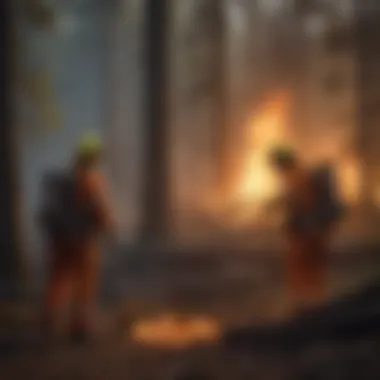Understanding Fire Checks: Essential Guide for Conservation


Intro
Fire checks are an essential element in effective forest management. Understanding their role requires a deep dive into the underlying ecosystems of woodlands. These ecosystems are vital for maintaining biodiversity and regulating the climate. Fire checks serve as a method to mitigate the impact of wildfires, which poses significant threats not only to forests but also to adjacent human communities.
In this guide, we will explore the concept of fire checks comprehensively. We will discuss their types, methods of implementation, and their importance for preventing wildfires and ensuring ecological health. This information is pertinent for forestry professionals as well as nature enthusiasts.
Understanding Woodland Ecosystems
Importance of Biodiversity in Forests
Biodiversity is the backbone of woodland ecosystems. It includes the variety of plant and animal life within these habitats. High biodiversity fosters resilience against disturbances, such as wildfires, diseases, and climate change. Various species contribute to ecosystem services, which include nutrient cycling, water regulation, and soil fertility.
When biodiversity is maintained, ecosystems can better withstand the pressures caused by external factors. Moreover, diverse forests support a range of wildlife, which is crucial for maintaining ecological balance. Effective fire checks can help preserve this diversity by preventing large-scale wildfires that threaten habitat integrity.
Role of Forests in Climate Regulation
Forests play a significant role in climate regulation. They act as carbon sinks, absorbing carbon dioxide from the atmosphere and thus mitigating climate change impacts. Additionally, forests influence local weather patterns, helping to maintain humidity and temperature levels.
The interplay between forests and climate is complex. Deforestation and mismanagement, including inadequate fire check strategies, can lead to increased greenhouse gas emissions. Implementing effective fire checks not only helps in wildfire prevention but also supports the broader goal of climate stability.
Sustainable Forestry Practices
Principles of Sustainable Forestry
Sustainable forestry aims to manage forest resources responsibly to meet current needs without compromising future generations. It involves practices that balance ecological, economic, and social factors. Key principles include:
- Maintaining ecological integrity: Ensuring that forest operations maintain natural habitats and biodiversity.
- Minimizing environmental impact: Reducing the ecological footprint of logging operations and land use changes.
- Engaging local communities: Involving communities in decision-making enhances outcomes and fosters stewardship.
These principles guide the implementation of fire checks in sustainable forestry practices. Effective fire management strategies protect both the environment and the livelihoods dependent on these ecosystems.
Case Studies of Successful Implementations
Examining real-world examples reveals the impact of well-executed fire management strategies.
- California, USA: After experiencing extreme wildfires, California implemented extensive fire check systems. These include controlled burns and strategically placed fire breaks.
- Australia's Forestry Management: In response to devastating wildfires, Australia's practices focus on fire prevention through the maintenance of natural barriers and fuel reduction techniques.
These cases demonstrate how proactive fire management can significantly enhance forest resilience and protect biodiversity.
Woodland Stewardship Techniques
Forest Management Plans
A robust forest management plan outlines strategies for maintaining forest health and minimizing wildfire risks. Such plans typically include:
- Assessment of forest health and dangers.
- Implementation of fire checks and controlled burns.
- Continuous monitoring and adaptive management based on changing conditions.
These plans are essential to ensure that forests are not only managed for timber production but also for ecological health and resilience.
Conservation Strategies
Conservation strategies focus on protecting and restoring ecosystems. These may involve enhancing connectivity between habitats and restoring native vegetation. When communities invest in conservation, they create a network of fire checks that naturally inhibits the spread of wildfires.
"Effective conservation enhances biodiversity and builds resilience against climate change and wildfires."
Furthermore, community engagement in conservation initiatives can lead to innovative solutions tailored to local conditions. This holistic approach facilitates a sustainable future for woodlands, benefiting both the environment and society.
Intro to Fire Checks
Understanding fire checks is essential for successful forest management. These measures play a pivotal role in controlling wildfires and preserving ecological integrity. By implementing fire checks, forestry professionals can mitigate the risks posed by uncontrolled fires. They are not merely barriers to fire; they represent a fundamental strategy for managing landscapes. The knowledge surrounding fire checks is crucial for both practitioners and researchers in this field.
Definition and Purpose
Fire checks refer to various techniques and physical structures designed to interrupt the spread of wildfires. Their primary purpose is to create defensible space around high-value areas like homes, structures, and sensitive ecological zones. These methods can include physical firebreaks, fuel reduction zones, and natural deterrents such as bodies of water or rocky formations. They are key components in both wildfire prevention and suppression efforts. In addition to this, fire checks assist in resource management by reducing the density of fuel loads, like brush and downed trees, which can exacerbate the severity of wildfires.
Historical Context
The use of fire checks has deep historical roots, reflecting ongoing human interaction with the environment. Early civilizations recognized that fire could both benefit and threaten their habitats. Indigenous people utilized controlled burns to manage landscapes, promote growth, and prevent larger wildfires. Over centuries, the understanding of fire's role within ecosystems evolved, leading to more structured approaches in fire management. In the 20th century, the advent of national forest services, particularly in the United States, emphasized creating fire checks as a proactive measure against wildfires, addressing the increasing challenges posed by urban expansion into wilderness areas.
Significance in Forest Management
Fire checks are integral to modern forest management programs. They directly impact fire behavior, allowing for better control and even suppression of wildfires. Moreover, well-maintained fire checks can enhance biodiversity by creating mixed habitats that support a variety of flora and fauna. This can encourage ecologically sustainable practices that align with conservation efforts. Additionally, the presence of fire checks serves as a crucial factor in disaster preparedness, allowing communities and land managers to respond effectively to wildfire threats.


"Properly designed and maintained fire checks can significantly reduce fire intensity, protecting both human life and natural resources."
Types of Fire Checks
Understanding the various types of fire checks is crucial in the realm of forest management. Fire checks serve as barriers, designed to limit the spread of wildfires while safeguarding both natural resources and human settlements. Each type has unique characteristics, advantages, and disadvantages, making them suitable for different environments and conditions. This section delves into both physical and natural fire checks, elucidating their significance in effective fire management strategies.
Physical Fire Checks
Physical fire checks involve human-made structures that can hinder the progress of fires. These checks can be managed and adjusted according to the needs of the area, providing adaptability in various situations. They are crucial in mitigating fire risks by removing fuels or altering the landscape to reduce fire intensity.
Clearings
Clearings are open spaces devoid of vegetation, created intentionally to separate fuel sources and minimize fire spread. The key characteristic of clearings is their ability to act as a buffer zone against advancing fires. This makes them a beneficial choice in fire-prone areas. A unique feature of clearings is that they can be strategically placed along potential fire paths, providing firefighters a critical advantage in suppression efforts.
However, clearings also have disadvantages, as they can lead to soil erosion or negatively impact local wildlife habitats if not managed properly. The balance between effective firefighting and ecological preservation is important when creating clearings.
Firebreaks
Firebreaks are strips of land where vegetation has been removed or treated to create a gap that can stop or slow down the movement of fire. The essential characteristic of firebreaks is their width, which can vary based on the fire hazard in the area. They are widely recognized for their ability to provide protection for communities and critical infrastructure. Firebreaks are often designed to be cost-effective solutions for wildfire management.
A unique feature of firebreaks is that they can be constructed using various methods, such as plowing, spraying herbicides, or controlled burns, depending on the surrounding environment. However, if not regularly maintained, firebreaks can become ineffective due to vegetation regrowth, necessitating ongoing attention.
Fuel Reduction Zones
Fuel Reduction Zones are areas where vegetation density is intentionally lowered through selective thinning or controlled burns. Their primary contribution to fire management is reducing the potential intensity and spread of fires. The key characteristic of these zones is their dual role, functioning both as preventive measures and as habitats that can sustain ecological integrity.
The unique feature of Fuel Reduction Zones involves careful planning to maintain biodiversity while achieving fire safety objectives. One disadvantage is that the implementation can be labor-intensive and requires ongoing management to ensure ecological balance and effectiveness.
Natural Fire Checks
Natural fire checks utilize existing landscape features that can enhance fire management efforts. These checks are often more sustainable because they work with the natural environment, requiring less physical intervention.
Water Bodies
Water bodies, such as lakes and rivers, provide a natural barrier against wildfires. Their key characteristic is the moisture content, which can dramatically reduce the chances of fire spreading across or near them. Using water bodies as fire checks is a popular choice as they are naturally occurring and do not require extensive alterations to the landscape.
A unique feature of water bodies is that they can also offer resources for firefighting, such as access to water for helicopter drops or firefighters’ use. However, limitations include potential drought conditions that can reduce their effectiveness during critical fire seasons.
Rock Formations
Rock formations can serve as natural barriers to fire due to their lack of flammable material. The essential characteristic of rock formations is that they are physically impenetrable by fire, thus providing a reliable boundary. Their effectiveness as natural fire checks is beneficial, making them a preferred choice in rugged terrains.
A unique aspect of rock formations is that they contribute to landscape diversity and provide habitat niches for various wildlife species. On the downside, their locations may not always align with strategic fire management needs, requiring additional consideration in planning.
Terrain Variation
Terrain variation, comprising changes in elevation and landform, can influence fire behavior and spread. The key characteristic is that steep slopes can hinder fire advancement, making them advantageous natural fire checks. Properly utilizing terrain variation can be a highly effective and beneficial choice in many forest management plans.
However, implementing terrain variation as a fire check needs careful consideration of visibility and accessibility for firefighting efforts. Without strategic planning, even favorable terrain can pose challenges during a wildfire situation.
Understanding these types of fire checks contributes to better planning and management, ultimately aiding in the significant goal of preserving forest health and preventing wildfires.
Designing Effective Fire Checks
Designing effective fire checks is an essential process that influences the overall effectiveness of wildfire management strategies. This section will explore critical elements involved in designing these checks, their inherent benefits, and important considerations that must be taken into account to ensure their success in forest management.
Site Assessment
A comprehensive site assessment is vital before the implementation of fire checks. This includes evaluating the physical characteristics of the land, such as
- Topography: Understanding the terrain can reveal natural barriers and routes that wildfires may follow.
- Vegetation Types: Different plant species have varying levels of flammability. Knowing this helps in designing checks that effectively reduce fire risk.
- Soil Conditions: The moisture content and type of soil affect how fires spread and how effective certain fire checks will be.
A thorough assessment informs the necessary adjustments that must be made to create effective fire checks, tailored to specific landscapes. Accurate data collection is crucial to optimize strategies for fire prevention and management.
Materials and Methods
Selecting appropriate materials and methods plays a significant role in constructing effective fire checks. Various materials are available, each with its own advantages. Some common methods include:
- Creating Firebreaks: These are cleared areas devoid of combustible materials that can stop or slow the fire’s movement. They should be wide enough to serve their purpose effectively.
- Using Native Plants: Incorporating fire-resistant plants in the design helps maintain ecological balance while reducing the risk of fire spread.
- Installing Water Sources: These can serve as additional fire checks by providing necessary moisture to areas at risk.
Environmental factors should guide the choice of materials, ensuring compatibility with the existing ecosystem. This harmonization is necessary for fostering sustainable practices in forest management.


Integration with Existing Ecosystems
Incorporating fire checks within existing ecosystems is crucial for maintaining ecological integrity.
- Biodiversity Considerations: It is essential to ensure that fire checks do not disrupt local wildlife habitats or biodiversity. Maintaining corridors for fauna is vital during implementation.
- Ecosystem Services: Understanding how fire checks affect services like water regulation, soil formation, and carbon storage is necessary to support broader environmental goals.
- Long-term Monitoring: After implementing fire checks, ongoing assessment of their impact on the ecosystem helps refine methods and ensure their resilience.
To maximize the benefits of fire checks, synergy with the environment must always be a priority. This ensures that the solution is not just effective in fire prevention but also supports the health of the forest as a whole.
Effective integration of fire checks with ecosystems contributes to both wildfire prevention and ecological health.
By carefully designing fire checks using detailed site assessments, appropriate materials, and thoughtful integration into existing ecosystems, forest managers can create a robust defense against wildfires. This approach fosters not only wildfire management but also promotes sustainable forest stewardship.
Implementation Strategies
In the context of fire management, implementation strategies are critical. They underpin the practical application of fire checks, influencing their effectiveness and sustainability. Addressing this subject is essential for a nuanced understanding of how to prevent wildfires and preserve ecosystems. These strategies define how various stakeholders—such as government bodies, private landowners, and community organizations—can work together to create fire checks that function optimally under diverse environmental conditions.
Community Collaboration
Engaging the community is vital for successful fire check implementation. Community collaboration cultivates a sense of ownership and responsibility among local populations. When communities are involved, they can contribute valuable insights into local environmental conditions and fire risks. This participation can take various forms:
- Public Workshops: Educational sessions where community members learn about fire safety and the importance of fire checks.
- Volunteer Programs: Initiatives where locals actively participate in the creation and maintenance of fire checks.
- Stakeholder Meetings: Regular gatherings inclusive of local government, non-profits, and residents to discuss ongoing fire management strategies.
Through these measures, communities can share resources, knowledge, and enthusiasm, making the process both empowering and effective.
Regulatory Guidelines
The framework of regulatory guidelines provides a structured approach to implementing fire checks. These guidelines often emerge from local, state, and federal regulations, shaped by ecological assessments and fire risk evaluations. Important considerations include:
- Zoning Laws: Regulations that dictate land use, potentially affecting where fire checks can be placed.
- Environmental Impact Assessments: Studies required to evaluate how fire checks influence local ecosystems.
- Fire Management Plans: Strategic documents detailing specific actions for fire prevention and response, guiding fire check installation and upkeep.
Adhering to these guidelines not only ensures compliance but also aligns fire management initiatives with broader conservation goals.
Monitoring and Maintenance
Monitoring and maintenance are essential components of effective fire check strategies. Once established, fire checks require regular evaluation to ensure they perform their intended function. Key practices include:
- Regular Inspections: Scheduled assessments help identify any deterioration or changes in vegetation that could affect fire breaks.
- Use of Technology: Implementing satellite imagery or drone surveillance to monitor large areas with accuracy.
- Feedback Loops: Engaging the community and other stakeholders provides updates and suggestions for modifications based on current conditions.
The success of fire checks hinges not only on their creation but also on their ongoing support and evolution in response to environmental changes. By implementing a robust monitoring and maintenance program, stakeholders can maximize the longevity and effectiveness of fire checks, thereby reducing wildfire risks and enhancing ecological health.
Effective fire management is not a one-time effort, but a continuous commitment to community and ecosystem resilience.
Challenges and Considerations
In understanding fire checks, it is crucial to recognize the challenges and considerations that can arise during their implementation. These factors can influence the effectiveness of fire checks and determine their impact on the surrounding ecosystem. Addressing these challenges is not just an academic exercise; it directly affects forest management strategies and the preservation of ecological balance.
Environmental Impact
Managing the environmental impact of fire checks is essential. Construction can disturb the existing flora and fauna. The removal of vegetation can lead to soil erosion, impacting local wildlife and water quality. Efforts to create firebreaks or clearings may also inadvertently destroy habitats. Thus, a comprehensive environmental assessment is needed prior to any implementation.
Considerations can be made to mitigate these effects by employing methods that preserve local species and habitats. Moreover, strategic planning may focus on using native vegetation in restoration, helping ecosystems recover while fulfilling fire prevention goals.
"Integrating ecological principles into fire management ensures sustainability."
Economic Factors
Economic considerations also play a vital role in the establishment of fire checks. Budget constraints often limit resources for fire prevention measures. Analyzing the cost-effectiveness of fire checks can provide insight on where money should be invested. This means looking at potential savings from reduced wildfire damage versus the initial costs of constructing fire breaks or clearings.
Investments in fire checks might yield long-term savings by preserving timber resources and lowering insurance costs. However, careful calculation must ensure that investments are justifiable over time. While innovative technology can potentially reduce ongoing costs, the initial funding can be a significant barrier for some regions.
Social Dynamics
Fire management does not exist in a vacuum; social dynamics can influence its success. Local communities often have varied opinions about fire checks. These can range from support due to perceived safety increases, to opposition out of concerns over land use and access.
Community engagement is crucial for aligning fire management practices with local values and needs. This can foster trust and cooperative efforts in wildfire prevention. Educational outreach can also enlighten communities on the ecological benefits of fire checks and their role in protecting both nature and property.
Innovations in Fire Management
Innovations in fire management represent a crucial area of development in the field of forestry and ecology. As the challenges of wildfires continue to grow—exacerbated by climate change and urban encroachment—effective fire management strategies are essential. Innovations not only enhance existing practices but also pave the way for new methods that can significantly improve wildfire prevention and control.
These advancements can include a range of practical applications such as sophisticated monitoring technologies, predictive modeling, and adaptive management strategies. The benefit of adopting these innovations lies in their potential to increase efficiency and effectiveness, ultimately reducing the incidence of wildfires and protecting valuable ecosystems.


Technological Advances
Technological advances in fire management have emerged as a game changer in the industry. Remote sensing technology, for instance, is now commonplace. Drones equipped with thermal imaging cameras can identify hotspots in forested areas, enabling quicker response times. These devices allow forestry professionals to scan large areas efficiently, facilitating immediate action when a fire is detected.
Another significant advancement is the use of Geographic Information Systems (GIS) to analyze fire behavior. GIS enables fire managers to model fire spread scenarios based on various factors such as wind, terrain, and fuel type. This capability supports strategic planning and resource allocation, ensuring firefighters are deployed effectively and efficiently.
Moreover, machine learning algorithms are increasingly being employed to predict fire behavior. These systems analyze vast amounts of data, leading to more accurate forecasts and risk assessments. Through these predictions, firefighting resources can be optimized, improving response and possibly saving lives and property.
Research and Development
Research and development in the field of fire management continues to be vital for both understanding and mitigating the effects of wildfires. Ongoing studies focus on the ecological impacts of fire, informing better management practices that balance ecological health and fire containment.
One area of research is the exploration of fire-resistant plant species. By introducing these species into fire-prone regions, the spread of wildfires can be minimized. Furthermore, it helps in maintaining biodiversity, as these species can serve as natural barriers against fire propagation.
Collaboration between academic institutions and forest management agencies has led to innovative strategies being trialed in varied environments. These collaborative efforts often yield new insights about the most effective synthesis of traditional and modern fire management practices. In addition, public engagement and education are increasingly recognized as crucial components of research initiatives. By involving communities, initiatives can become more sustainable and widely accepted, facilitating broader adoption of innovative fire management solutions.
Case Studies
Case studies are essential in understanding the effectiveness of fire checks. They provide real-world examples, highlighting diverse approaches and techniques that have been applied in various settings. By examining both successes and failures, we can extract valuable lessons. These insights not only inform ongoing practices but also shape future strategies in fire management.
Successful Fire Check Implementations
Analyzing successful implementations of fire checks reveals effective methods that have led to significant reductions in wildfire occurrences. One example is the use of firebreaks in California, where land managers created wide swaths devoid of vegetation. This approach slowed the spread of wildfires, protecting communities and wildlife habitats.
Another instance occurred in Australia, where a comprehensive implementation of fuel reduction zones was employed. Controlled burns were strategically planned to decrease combustible materials. As a result, these zones acted as buffers against approaching fires, proving instrumental in protecting both forests and urban areas.
Furthermore, community involvement played a key role. Residents were trained on fire management practices, enhancing understanding and cooperation. Engaging local stakeholders increased the effectiveness of fire checks, ensuring that methods were well-suited to specific landscapes and community needs.
Lessons Learned from Failures
Failures in fire check implementations provide critical lessons for future practices. One noteworthy case in Florida highlighted the dangers of inadequate assessments prior to establishing firebreaks. Firebreaks were created in areas that had not been thoroughly evaluated for surrounding fuel loads. Consequently, these efforts did little to impede fire spread and sometimes even exacerbated conditions, proving costly in the long run.
In another situation, in the Mediterranean region, reliance on natural fire checks was overestimated. The assumption that rocky terrains would naturally suppress fire movement led to neglect in active fire management. Unfortunately, during dry seasons, fires spread rapidly, revealing the limitations of passive measures.
These experiences emphasize the importance of site assessment and continuous monitoring. Understanding local conditions and making adjustments based on environmental factors can mean the difference between success and failure in fire management.
"By learning from both successes and failures, practitioners can refine their strategies, ultimately leading to more resilient forest ecosystems."
In summary, case studies present an invaluable resource for forestry professionals. They encapsulate practical knowledge and contextual insights. Analyzing outcomes helps in forging more effective techniques in the management of fire checks for safeguarding forests.
Future Directions
As we move into an era of increasing environmental challenges, the future of fire management hinges on innovative strategies and flexible adaptability. This section aims to explore the critical elements shaping the landscape of fire checks and their role in sustainable forestry practices. Recognizing how these strategies evolve is essential for forestry professionals and academics alike, ensuring preparedness for the unpredictable nature of wildfires.
Predictions in Fire Management
The significance of predictive models in fire management cannot be understated. By leveraging advanced technology, forest managers can better anticipate fire behavior, taking into account variables such as climate change, vegetation types, and meteorological data. This allows for more precise fire prevention efforts. Machine learning algorithms analyze vast datasets, thereby improving accuracy in understanding how fires might spread in different conditions.
Alongside technology, collaborations between government agencies and research institutions will drive these predictive capabilities further. Enhanced data sharing will facilitate informed decision-making, balancing ecological health with preventative measures. Moreover, utilizing real-time tracking during fire events can guide rapid response teams, optimizing containment strategies and minimizing damage.
Emerging Trends in Forest Stewardship
Emerging trends in forest stewardship provide a glimpse into the future of effective fire management. A notable shift is the integration of traditional ecological knowledge with contemporary scientific methods. This approach encourages a holistic understanding of ecosystems, fostering greater community involvement in managing forest resources. Practices such as controlled burns, based on historical land use, are gaining recognition for their ability to reduce fuel loads and restore ecological integrity.
Additionally, regenerative forestry is transforming the way we manage landscapes affected by fire. Implementing practices that prioritize biodiversity can lead to more resilient ecosystems. For instance, promoting diverse plant species can significantly reduce the spread of wildfires. This multifaceted approach not only mitigates fire risks but also enhances the overall environmental health of forests.
In summary, the future directions in fire management are being shaped by predictive advancements and a commitment to integrating diverse stewardship practices. As we continue to face environmental uncertainties, how we adapt and innovate will ultimately define the effectiveness of our fire checks and management strategies.
"Sustainable fire management is not merely an option; it is a necessity in our changing world."
Continuous evaluation and adjustment will be critical as new trends emerge. Engaging with advancements in technology and practices will equip forestry professionals to address the complex interplay of fire dynamics with ecosystem health.
End
Effective fire checks are crucial in modern forest management practices. They serve as a preventive measure against wildfires while also promoting ecological balance. The importance of these tools cannot be overstated, as they significantly contribute to the sustainability of forest ecosystems and the safety of surrounding communities.
Recap of Fire Check Importance
In summary, fire checks function as barriers, mitigating the spread of wildfires. They help to reduce fuel loads and disrupt the continuity of combustible materials. This is essential for minimizing risks in prone areas. Fire checks also play a role in protecting biodiversity. Different types of checks, such as physical and natural methods, have unique advantages. For instance, water bodies and terrain variations can act as natural fire breaks. When well-planned and maintained, fire checks foster a healthier forest environment.
Call to Action for Practitioners
It is imperative for forestry professionals to actively engage in the implementation and maintenance of fire checks. Regular assessments are necessary to ensure they remain effective. Practitioners should also stay informed about the latest techniques and technologies in fire management. Collaboration with local communities and government bodies is vital for fostering broader awareness and understanding.
Investing in education and resources related to fire checks can lead to improved outcomes in forest management. Encouragement of research initiatives can yield innovative solutions tailored for diverse ecosystems. Collective action will enhance the resilience of natural landscapes, thereby safeguarding them from the growing threat of wildfires.
"The proactive management of fire checks is an investment in the future of forest sustainability."
By integrating these practices into daily operations, practitioners can make substantial contributions to the health of forests and the safety of nearby human settlements.







